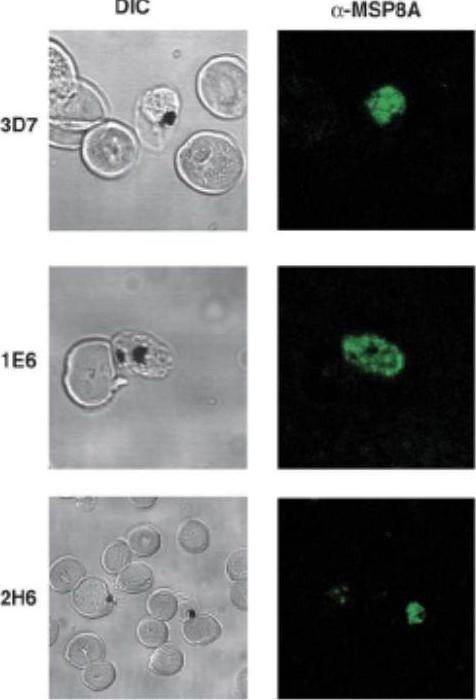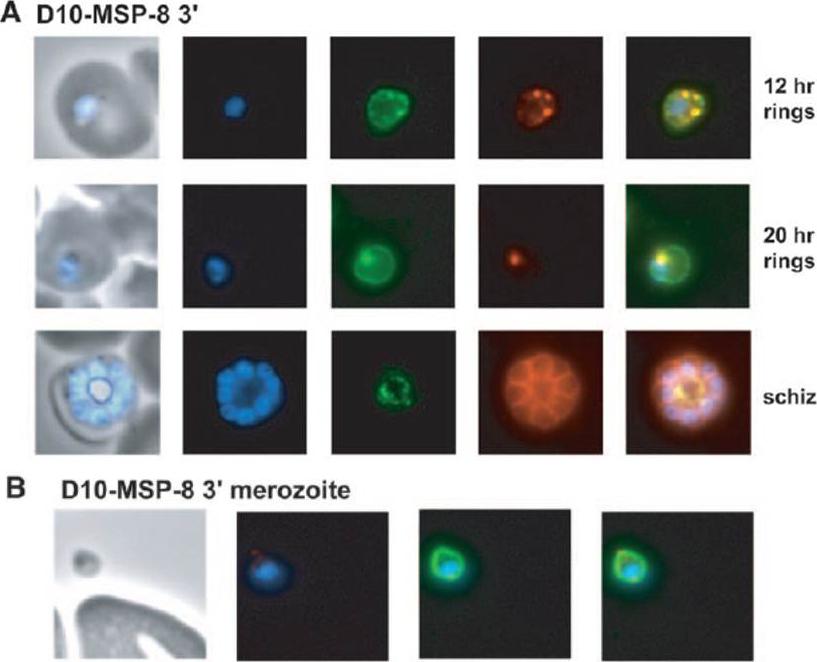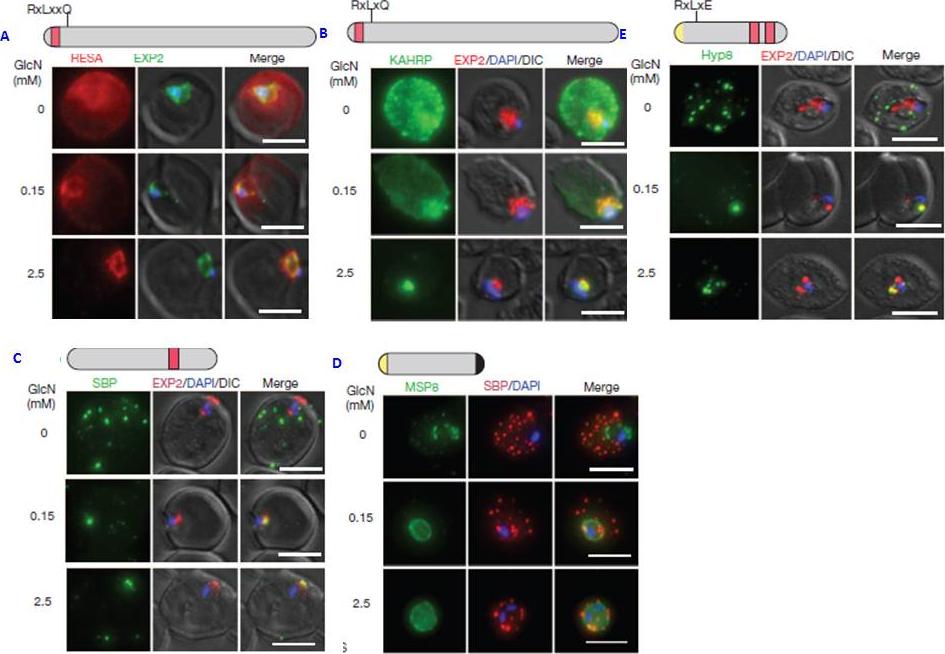PF3D7_0502400 merozoite surface protein 8 (MSP8)
Disruptability [+]
| Species | Disruptability | Reference | Submitter | |
|---|---|---|---|---|
| P. falciparum 3D7 |
Possible |
16125802 | Theo Sanderson, Wellcome Trust Sanger Institute | |
| P. falciparum 3D7 |
Possible |
USF piggyBac screen (Insert. mut.) | USF PiggyBac Screen | |
| P. falciparum 3D7 |
Possible |
16125802 | Theo Sanderson, Francis Crick Institute | |
| P. berghei ANKA |
Possible |
PlasmoGEM (Barseq) | PlasmoGEM | |
Mutant phenotypes [+]
| Species | Stage | Phenotype | Reference | Submitter |
|---|---|---|---|---|
| P. falciparum 3D7 | Asexual |
No difference |
16125802 | Theo Sanderson, Wellcome Trust Sanger Institute |
Imaging data (from Malaria Metabolic Pathways)

IFA of fixed late trophozoite stage 3D7 and DMSP8 and in 2 clones 1E6 and 2H6 where MSP8 was disrupted, using antiserum to the N-terminus of MSP8 (anti-MSP8A) followed by Alexa Fluor 488-conjugated anti-rabbit Ig (green). The pattern was consistent with an extra-parasite localisation, suggesting a secreted product. MSP8 is not required for asexual stage parasite growth and replication in vitro. Black CG, Wu T, Wang L, Topolska AE, Coppel RL. MSP8 is a non-essential merozoite surface protein in Plasmodium falciparum. Mol Biochem Parasitol. 2005 144:27-35. Copyright Elsevier 2009.
See original on MMP
PfMSP-8 localizes to the parasitophorous vacuole of ring-stage parasites and is absent from the surface of merozoites. (A) Double labeling IFA of fixed early-ring-stage, late-ring-stage, and schizont-stage using a mixture of rabbit antisera specific for the EGF-like domains of PfMSP-8 (PfMSP-8) and monoclonal antibody 4H9/19 specific for PfMSP-119 (aPfMSP-1). DAPI was used for nuclear staining (blue). PfMSP-8 (green) and PfMSP-1 (red) colocalized in the parasitophorous vacuole of early-ring-stage P. falciparum parasites but not in the parasitophorous vacuole of late-stage P. falciparum parasites. (B) Double-labeling IFA of fixed merozoite-stage D10-MSP-8 3’, using a mixture of rabbit antisera specific for the EGF-like domains of PfMSP-8 and monoclonal antibody 4H9/19 specific for PfMSP-119 as described above. schiz, schizont. Proteolytic processing of MSP-1 generates a 19-kDa, C-terminal, membrane-associated fragment termed MSP-119 that is present on the surface of merozoites during erythrocyte invasion and remains associated with the parasite plasma membrane upon formation of the parasitophorous vacuole in an infected erythrocyte.Drew DR, Sanders PR, Crabb BS. Plasmodium falciparum merozoite surface protein 8 is a ring-stage membrane protein that localizes to the parasitophorous vacuole of infected erythrocytes. Infect Immun. 2005 73:3912-22.
See original on MMP
PTEX150 knockdown blocks protein export in P. falciparum. a–e, IFAs (right) and graphs (left) showing a decrease in the export of RESA (a) and KAHRP (b) and of SBP1 (c) and Hyp8 (d) (Maurer’s clefts, MCs) cells for each antibody or GlcN concentration) but similar levels of MSP8 (e) after treatment with GlcN. Scale bars, 5 mm. A strong blockage in export was seen at both 2.5mM and 0.15mM glucosamine in PTEX150-HAglmS parasites (a, b, c and d). No effect on either MSP8 expression or localization to the parasite membrane was observed (e).Elsworth B, Matthews K, Nie CQ, Kalanon M, Charnaud SC, Sanders PR, Chisholm SA, Counihan NA, Shaw PJ, Pino P, Chan JA, Azevedo MF, Rogerson SJ, Beeson JG, Crabb BS, Gilson PR, de Koning-Ward TF. PTEX is an essential nexus for protein export in malaria parasites. Nature. 2014 Jul 16. [Epub ahead of print] PMID: 25043043
See original on MMPMore information
| PlasmoDB | PF3D7_0502400 |
| GeneDB | PF3D7_0502400 |
| Malaria Metabolic Pathways | Localisation images Pathways mapped to |
| Previous ID(s) | MAL5P1.25, PFE0120c |
| Orthologs | PBANKA_1102200 , PCHAS_1101900 , PKNH_1031500 , PVP01_1032600 , PVX_097625 , PY17X_1103300 |
| Google Scholar | Search for all mentions of this gene |